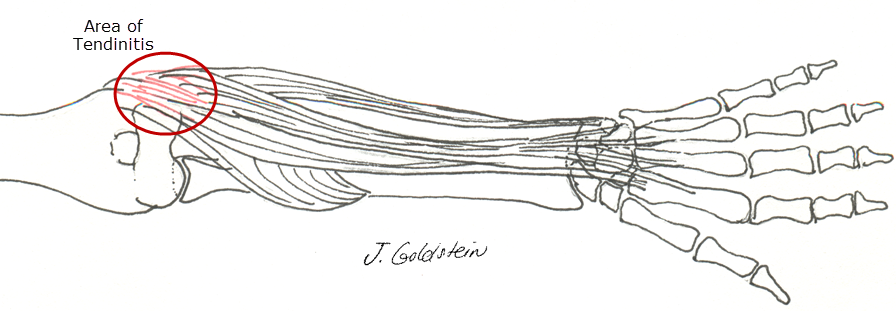Tendinitis

Sports or work-related tendon injuries often involve high repetitive loading of tendons with microscopic areas of rupture, surrounding inflammation and scar formation. In the tennis player, golfer or swimmer, this may be seen with a painful elbow or shoulder. In basketball this may be seen as patellar tendonitis of the knee, and in the runner, it may be seen as Achilles tendonitis. Causes of tendonitis include repetitive or acute tendon overload, constriction of a tendon sheath with associated tendon friction, direct blow to a tendon attachment site, or systemic diseases which cause generalized soft tissue inflammation. The site of injury may be at the anchor site of tendon to bone, the mid-substance of the tendon, or at the muscle-tendon junction. In tennis, lateral epicondylitis occurs at the bone-tendon origin of the wrist extensor muscles in the forearm. In golf, the medial epicondylitis is more commonly affected.
Symptoms
Pain is the primary symptom and is activity-related. In the early stages of tendonitis, the pain resolves within 24 hours of exercise. In the most severe cases, tendonitis may progress to constant rest pain which may disturb sleep or ultimately lead to tendon rupture and attendant mechanical dysfunction. Although local warmth may accompany local inflammation, this is not associated with fever or generalized symptoms.
Diagnosis
Diagnosis is usually based on history and physical exam. Rarely scans are necessary to make a diagnosis, except in instances where occult rupture is suspected, or other more serious problems are felt to be likely. Tendonitis must be differentiated from nerve entrapment syndromes, especially with elbow tendonitis, synovial sheath stenosis in the wrist or ankle, or generalized inflammatory conditions such as rheumatoid arthritis.
Prevention
Prevention of Tendinitis is accomplished by stretching the areas prone to injury and maintaining strength without tendon overload. “Warm-up” should occur before sports. It should include moving through the full range of the joint involved. Overuse injuries are to be avoided. This means decreased activity, away from the sport for rest. Equipment of lightweight with correct grip size is essential to avoid injury. In the case of tennis, string tension should be even and properly adjusted in the racquet. In tennis, new light materials and larger grip diameters may reduce tendon loads. Improved flexibility of racquet and club handles also reduces the risk of tendon injury. Muscle-strengthening will decrease the likelihood of tendon injury. Playing technique is important in avoiding injury. Excessive force or poor stroke mechanics in contacting the ball in golf and tennis may cause “tennis elbow” or “golfers elbow”.
Treatment
Treatment for Tendinitis centers on rest, oral anti-inflammatory medication, activity modification and local modalities for pain. Splinting the affected part rests the muscle origins which are injured. This is the reasoning for the use of wrist splinting in tendonitis at the elbow. Steroid injection around major load-bearing tendons is contraindicated. These medications slow healing through powerful local anti-inflammatory effects. In this way they may predispose an already compromised tendon to fail catastrophically, thereby necessitating Orthopedic surgical treatment. Stretching the affected muscle-tendon unit daily helps avoid stiffness and improves healing with minimal pain. Formal physical therapy is sometimes helpful in difficult cases. The most important aspect of treatment is the avoidance of aggravating activities. Modification of tennis racquet handles to larger diameters and more flexible shafts may allow earlier return to sports without pain. Splints may also allow earlier return to sports and should be worn initially at all times except at bed. Stroke modification may decrease irritation. Consult your golf or tennis pro for advice, and remember that avoidance of pain is critical to rapid healing. As you return to sports play carefully at first to avoid repeat tendon injury.
Rehabilitation
Weak muscles are a common cause of elbow Tendinitis in tennis players. Gentle stretching of the wrist and elbow should be through a full range of motion including rotation daily. As pain and inflammation subside, strengthening exercises are added on a daily basis. Light wrist curls in flexion and extension with the forearm supported on a table, and rotation using a Theraband Flexbar is also helpful. Strengthening exercises should always be performed without pain. As strength improves, sports participation may be slowly resumed. Tendinitis may be slow and difficult to cure, and prone to recurrence, but in general surgical intervention is only occasionally indicated.
Compliments of Sports Medicine and Orthopaedics, East Providence, Rhode Island
